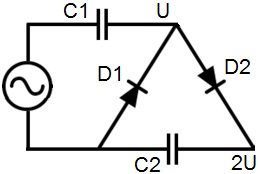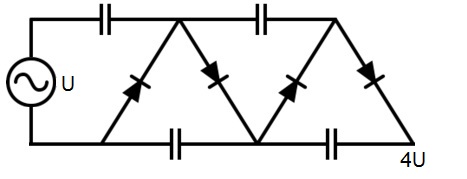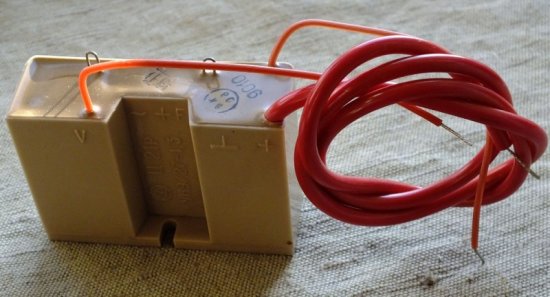Voltage multiplier
What if you charge the capacitors in parallel or one at a time, then connect them in series and use the resulting battery as a source of higher voltage? But this is a well-known way of increasing voltage, called multiplication.
Using a voltage multiplier, a higher voltage can be obtained from a low voltage source without the need for a step-up transformer for this purpose. In some applications, the transformer will not work at all, and sometimes it is much more convenient to use a multiplier to increase the voltage.
For example, in TVs manufactured in the USSR, a voltage of 9 kV can be obtained from a linear transformer and then already increased to 27 kV using a multiplier UN9 / 27-1.3 (the marking means that 9 kV is supplied to the input, 27 kV at a current of 1.3 mA is obtained at the output).
Imagine if you had to get such a voltage for a CRT TV using only one transformer? How many turns must be wound in its secondary winding and how thick will the wire be? This would result in a waste of materials.As a result, it turns out that for obtaining high voltages, if the required power is not high, a multiplier is quite suitable.
A voltage multiplier circuit, whether low voltage or high voltage, contains only two types of components: diodes and capacitors.
The function of the diodes is to direct the charge current into the respective capacitors, and then direct the discharge current from the respective capacitors in the right direction so that the objective (getting an increased voltage) is achieved.
Of course, an AC or wave voltage is applied to the multiplier, and often this source voltage is taken from the transformer. And at the output of the multiplier, thanks to the diodes, the voltage will now be constant.

Let's look at how the multiplier works, using a doubler as an example. When the current at the very beginning moves down from the source, the nearby upper capacitor C1 is charged first and most intensively through the nearby lower diode D1, while the second capacitor according to the scheme does not receive a charge, because it is blocked by the diode.
Also, since we have an AC source here, the current travels up from the source, but here along the way there is charged capacitor C1, which now turns out to be connected in series with the source and through the diode D2, the capacitor C2 receives a charge at a higher voltage, thus the voltage on it is higher than the amplitude of the source (minus the losses in the diode, in the wires, in the dielectric and others.).).
In addition, the current again moves downward from the source—capacitor C1 is recharged.And if there is no load, after a few periods the voltage across the capacitor C2 will be maintained at about 2 amplitude voltage of the source. Likewise, you can add more sections to get higher voltages.
However, as the number of stages in the multiplier increases, the output voltage first becomes higher and higher, but then rapidly decreases. In practice, more than 3 steps are rarely used in multipliers. After all, if you put too many steps, then losses will increase, and the voltage of distant sections will be less than desired, not to mention the weight and dimensions of such a product.
By the way, voltage doubling is traditionally used in microwave ovens. MOT (frequency 50 Hz), but tripling, in multiples such as UN, is applied to a high-frequency voltage measured in tens of kilohertz.

Today, in many technical fields where high voltage with low current is required: in laser and X-ray technology, in display backlight systems, in magnetron power circuits, in air ionizers, particle accelerators, in copying technology, multipliers are took root well.

